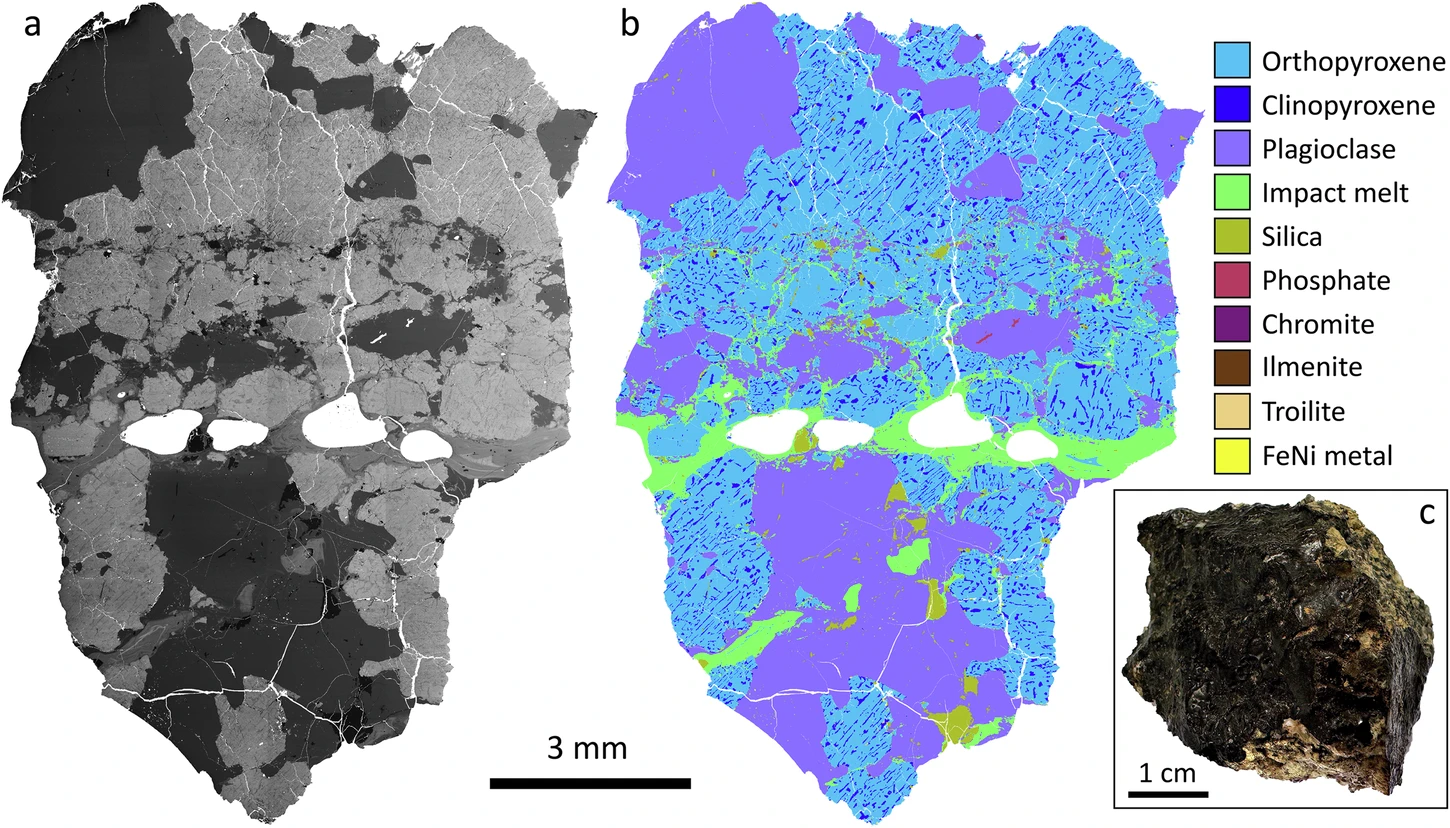Lunar meteorite discovery supports Purdue-led model of early Moon evolution
05-07-2025

Dr. Tabb Prissel, assistant professor with the Department of Earth, Atmospheric, and Planetary Sciences (EAPS) at Purdue University. (Photo provided by Purdue University)
A rock that crash-landed on Earth has made lunar science history, and a Purdue scientist played a key role in modeling its formation history. For the first time, researchers have classified a whole-rock meteorite as a lunar norite (Arguin 002), an igneous lunar rock type primarily comprised of the minerals orthopyroxene and plagioclase feldspar.
Lunar norites are an important component of the Moon’s crust and are chemically linked to some of the most ancient magmas on the Moon. The whole-rock nature of Arguin 002 is a rare find and one that directly supports an evolutionary model put forward by Purdue University’s Tabb Prissel.
The research first unfolded when Prissel, an assistant professor in the Department of Earth, Atmospheric, and Planetary Sciences (EAPS), led an international study published in Nature Communications (2023) that unified geochronological data from returned Apollo samples, orbital mission data of the lunar surface, and geodynamic models of the early lunar interior.
Prissel explained, “Our unifying model suggests that the earliest volcanic activity on the Moon was widespread and happened nearly all at once, driven by extensive movement or convection in the Moon’s mantle.” This concept contests the widely held notion that lunar volcanic activity was mainly fueled by heat from radioactive elements.
This significant advance to planetary science earned Prissel the NASA Superior Accomplishment Award, and his work is currently a featured publication in Nature’s Special Collection “Geology of the Moon,” which highlights breakthrough studies shedding new light on lunar evolution.
To test Prissel’s hypothesis further, samples recovered from beyond previous landing sites would be needed, and this is where Arguin 002 comes into the story. Prissel has now co-authored a new international study in Nature Communications Earth & Environment (2025), where he played a pivotal role in guiding the unprecedented analysis of Arguin 002.
Lunar meteorites are an integral contribution to the lunar rock record as they come from a wide range of, albeit random, locations across the lunar surface. The age of formation and chemical composition identified for Arguin 002 resemble the calculations from Prissel’s previous models, bolstering their conclusions with fresh “ground truth.”

a Mosaic backscattered electron (BSE) image of Arguin 002 with enhanced contrast, taken with TIMA. b Image depicting the mineral distribution in Arguin 002, taken with TESCAN Integrated Mineral Analyzer (TIMA). c Hand specimen photo of Arguin 002. (Figure provided by Tabb Prissel)
Prissel tells us that the Moon’s early geology was like a simmering pot of chili: “Imagine the Moon’s early geologic history as a pot of chili just starting to bubble on the stove,” says Prissel. “Scientists commonly think that the first bubbling, representing ancient volcanic activity, was fueled largely by spicy ingredients like jalapenos or Fresno chiles (heat from radioactive elements). However, when we analyzed the Arguin 002 meteorite, it wasn’t very spicy at all! Our findings suggest that the bubbling was instead powered by convection currents throughout the chili that were circulating heat and energy from the bottom of the pot. This global mantle convection process is challenging how we understand the Moon’s early volcanic history, and Arguin 002 provides direct sample evidence to support this.”
This may be the start of something even more impactful. Arguin 002 likely originated from the Moon’s South Pole–Aitken basin and is invaluable for studying magmatic and volcanic activity in previously unexplored lunar regions. This area of the Moon, described by the National Academy of Sciences as the most significant and oldest impact feature observable in the inner solar system, is a key target for upcoming NASA Artemis missions. Prissel and colleagues are thus providing critical insight for human space exploration plans, including those being shaped by NASA’s new SPARX (South Pole–Aitken Basin Sample Return and eXploration) Science Definition Team.
Prissel’s research program at Purdue University focuses on the igneous evolution of Earth, the Moon, and other rocky bodies. It combines lab experiments with planetary data and geochemical modeling. Prissel will lead a research group in the upcoming Purdue Petrology Suite, a facility dedicated to experimentally investigating the chemistry and mineralogy of volcanoes and planetary interiors.
Prissel is also an Instrument Scientist Lead for PRECISE (Purdue Resources Empowering Coordinated Investigations for Sample Exploration), the NASA Planetary Science Enabling Facility at Purdue, which provides no-cost access to 13 world-class laboratories for coordinated sample analysis studies.
About the Department of Earth, Atmospheric, and Planetary Sciences at Purdue University
The Department of Earth, Atmospheric, and Planetary Sciences (EAPS) combines four of Purdue’s most interdisciplinary programs: Geology & Geophysics, Environmental Sciences, Atmospheric Sciences, and Planetary Sciences. EAPS conducts world-class research, educates undergraduate and graduate students, and provides our college, university, state and country with the information necessary to understand the world and universe around us. Our research is globally recognized, our students are highly valued by graduate schools, employers, and our alumni continue to make significant contributions in academia, industry, and federal and state government.
Written by: David Siple, Communications Specialist, in the Department of Earth, Atmospheric, and Planetary Sciences (EAPS) at Purdue University.
Contributions by: Dr. Tabb Prissel, assistant professor with the Department of Earth, Atmospheric, and Planetary Sciences (EAPS) at Purdue University.